Entity Framework应用:使用Code First模式管理数据库创建和填充种子数据
一、管理数据库连接
1、使用配置文件管理连接之约定
在数据库上下文类中,如果我们只继承了无参数的DbContext,并且在配置文件中创建了和数据库上下文类同名的连接字符串,那么EF会使用该连接字符串自动计算出数据库的位置和数据库名。比如,我们的数据库上下文定义如下:
using System;
using System.Collections.Generic;
using System.Data.Entity;
using System.Linq;
using System.Text;
using System.Threading.Tasks; namespace ConventionConfigure.EF
{
/// <summary>
/// 继承无参数的DbContext
/// </summary>
public class SampleDbEntities :DbContext
{
public SampleDbEntities()
{
// 数据库不存在时创建数据库
Database.CreateIfNotExists();
}
}
}
在配置文件中定义的连接字符串如下:
<connectionStrings>
<add name="SampleDbEntities" connectionString="Data Source=.;Initial Catalog=TestDb;Integrated Security=True;MultipleActiveResultSets=True" providerName="System.Data.SqlClient" />
</connectionStrings>
定义的连接字符串中name的value值和创建的数据库上下文类的类名相同,这样EF会使用该连接字符串执行数据库操作,究竟会发生什么呢?
运行程序,Program类定义如下:
using ConventionConfigure.EF;
using System;
using System.Collections.Generic;
using System.Linq;
using System.Text;
using System.Threading.Tasks; namespace ConventionConfigure
{
class Program
{
static void Main(string[] args)
{
using (var context = new SampleDbEntities())
{ } Console.WriteLine("创建成功");
Console.ReadKey();
}
}
}
当运行应用程序时,EF会寻找我们的数据库上下文类,即“SampleDbEntities”,并在配置文件中寻找和它同名的连接字符串,然后它会使用该连接字符串计算出应该使用哪个数据库provider,之后检查数据库位置,之后会在指定的位置创建一个名为TestDb.mdf的数据库文件,同时根据连接字符串的Initial Catalog属性创建了一个名为TestDb的数据库。创建的数据库结构如下:
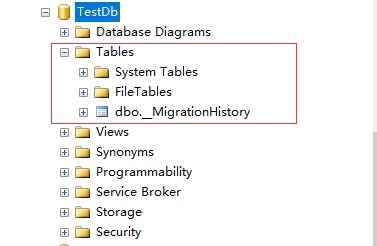
查看创建后的数据库,会发现只有一张迁移记录表。
2、使用已经存在的ConnectionString
如果我们已经有了一个定义数据库位置和名称的ConnectionString,并且我们想在数据库上下文类中使用这个连接字符串,连接字符串如下:
<connectionStrings>
<add name="AppConnection" connectionString="Data Source=.;Initial Catalog=TestDb;Integrated Security=True;MultipleActiveResultSets=True" providerName="System.Data.SqlClient" />
</connectionStrings>
以上面创建的数据库TestDb作为已经存在的数据库,新添加实体类Student,使用已经存在的ConnectionString查询数据库的Student表,Student实体类定义如下:
using System;
using System.Collections.Generic;
using System.ComponentModel.DataAnnotations.Schema;
using System.Linq;
using System.Text;
using System.Threading.Tasks; namespace ExistsConnectionString.Model
{
[Table("Student")]
public class Student
{
public int Id { get; set; } public string Name { get; set; } public string Sex { get; set; } public int Age { get; set; }
}
}
我们将该连接字符串的名字传入数据库上下文DbContext的有参构造函数中,数据库上下文类定义如下:
using ExistsConnectionString.Model;
using System;
using System.Collections.Generic;
using System.Data.Entity;
using System.Linq;
using System.Text;
using System.Threading.Tasks; namespace ExistsConnectionString.EF
{
public class SampleDbEntities : DbContext
{
public SampleDbEntities()
: base("name=AppConnection")
{ } // 添加到数据上下文中
public virtual DbSet<Student> Students { get; set; }
}
}
上面的代码将连接字符串的名字传给了DbContext类的有参构造函数,这样一来,我们的数据库上下文就会开始使用该连接字符串了,在Program类中输出Name和Age字段的值:
using ExistsConnectionString.EF;
using System;
using System.Collections.Generic;
using System.Linq;
using System.Text;
using System.Threading.Tasks; namespace ExistsConnectionString
{
class Program
{
static void Main(string[] args)
{
using (var context = new SampleDbEntities())
{
foreach (var item in context.Students)
{
Console.WriteLine("姓名:"+item.Name+" "+"年龄:"+item.Age);
}
}
}
}
}
运行程序,发现会报下面的错误:
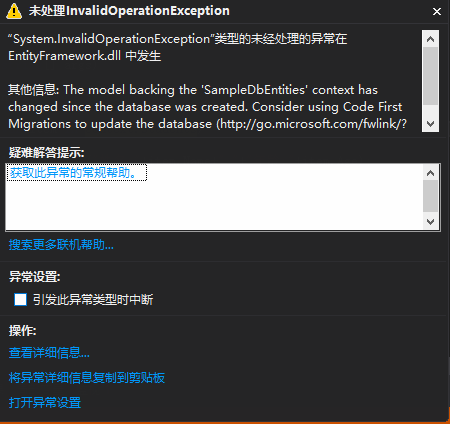
出现上面报错的原因是因为数据库上下文发生了改变,与现有数据库不匹配。解决方案:
1、把数据库里面的迁移记录表删掉或者重命名即可。
重新运行程序,结果如下:
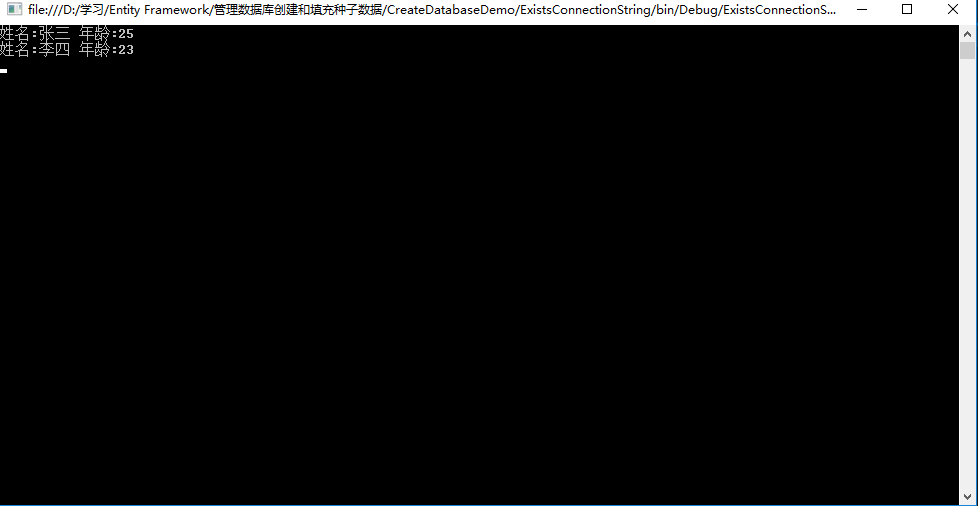
注意:如果在配置文件中还有一个和数据库上下文类名同名的ConnectionString,那么就会使用这个同名的连接字符串。无论我们对传入的连接字符串名称如何改变,都是无济于事的,也就是说和数据库上下文类名同名的连接字符串优先权更大。(即约定大于配置)
3、使用已经存在的连接
通常在一些老项目中,我们只会在项目中的某个部分使用EF Code First,同时,我们想对数据上下文类使用已经存在的数据库连接,如果要实现这个,可将连接对象传给DbContext类的构造函数,数据上下文定义如下:
using ExistsDbConnection.Model;
using System;
using System.Collections.Generic;
using System.Data.Common;
using System.Data.Entity;
using System.Linq;
using System.Text;
using System.Threading.Tasks; namespace ExistsDbConnection.EF
{
public class SampleDbEntities :DbContext
{
public SampleDbEntities(DbConnection con)
: base(con, contextOwnsConnection: false)
{ } public virtual DbSet<Student> Students { get; set; }
}
}
这里要注意一下contextOwnsConnection参数,之所以将它作为false传入到上下文,是因为它是从外部传入的,当上下文超出了范围时,可能会有人想要使用该连接。如果传入true的话,那么一旦上下文出了范围,数据库连接就会立即关闭。
Program类定义如下:
using System;
using System.Collections.Generic;
using System.Data.Common;
using System.Data.SqlClient;
using System.Linq;
using System.Text;
using System.Threading.Tasks;
using System.Configuration;
using ExistsDbConnection.EF; namespace ExistsDbConnection
{
class Program
{
static void Main(string[] args)
{
// 读取连接字符串
string conn = ConfigurationManager.ConnectionStrings["AppConnection"].ConnectionString;
// DbConnection是抽象类,不能直接实例化,声明子类指向父类对象
DbConnection con = new SqlConnection(conn);
using (var context = new SampleDbEntities(con))
{
foreach (var item in context.Students)
{
Console.WriteLine("姓名:" + item.Name + " " + "年龄:" + item.Age);
}
} Console.WriteLine("读取完成");
Console.ReadKey();
}
}
}
运行程序,结果如下:
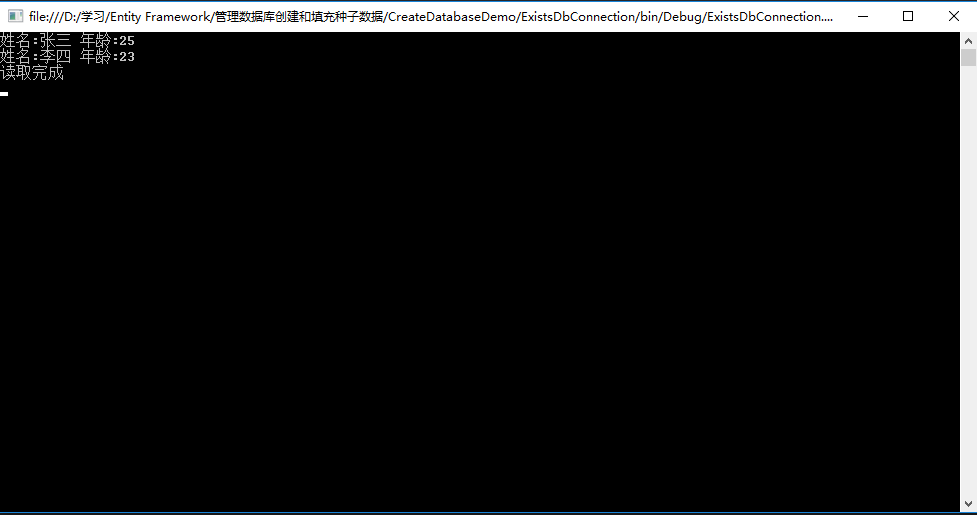
二、管理数据库创建
首次运行EF Code First应用时,EF会做下面的这些事情:
1、检查正在使用的DbContext类。
2、找到该上下文类使用的connectionString。
3、找到领域实体并提取模式相关的信息。
4、创建数据库。
5、将数据插入系统。
一旦模式信息提取出来,EF会使用数据库初始化器将该模式信息推送给数据库。数据库初始化器有很多可能的策略,EF默认的策略是如果数据库不存在,那么就重新创建;如果存在的话就使用当前存在的数据库。当然,我们有时也可能需要覆盖默认的策略,可能用到的数据库初始化策略如下:
CreateDatabaseIfNotExists:CreateDatabaseIfNotExists:顾名思义,如果数据库不存在,那么就重新创建,否则就使用现有的数据库。如果从领域模型中提取到的模式信息和实际的数据库模式不匹配,那么就会抛出异常。
DropCreateDatabaseAlways:如果使用了该策略,那么每次运行程序时,数据库都会被销毁。这在开发周期的早期阶段通常很有用(比如设计领域实体时),从单元测试的角度也很有用。
DropCreateDatabaseIfModelChanges:这个策略的意思就是说,如果领域模型发生了变化(具体而言,从领域实体提取出来的模式信息和实际的数据库模式信息失配时),就会销毁以前的数据库(如果存在的话),并创建新的数据库。
MigrateDatabaseToLatestVersion:如果使用了该初始化器,那么无论什么时候更新实体模型,EF都会自动地更新数据库模式。这里很重要的一点是:这种策略更新数据库模式不会丢失数据,或者是在已有的数据库中更新已存在的数据库对象。MigrateDatabaseToLatestVersion初始化器只有从EF4.3才可用。
1、设置初始化策略
EF默认使用CreateDatabaseIfNotExists作为默认初始化器,如果要覆盖这个策略,那么需要在DbContext类中的构造函数中使用Database.SetInitializer方法,下面的例子使用DropCreateDatabaseIfModelChanges策略覆盖默认的策略。数据库上下文类定义如下:
using InitializationStrategy.Model;
using System;
using System.Collections.Generic;
using System.Data.Entity;
using System.Linq;
using System.Text;
using System.Threading.Tasks; namespace InitializationStrategy.EF
{
public class SampleDbEntities : DbContext
{
public SampleDbEntities()
: base("name=AppConnection")
{
// 使用DropCreateDatabaseIfModelChanges策略覆盖默认的策略
Database.SetInitializer<SampleDbEntities>(new DropCreateDatabaseIfModelChanges<SampleDbEntities>());
} // 添加到数据上下文中
public virtual DbSet<Student> Students { get; set; }
}
}
这样一来,无论什么时候创建上下文类,Database.SetInitializer()方法都会被调用,并且将数据库初始化策略设置为DropCreateDatabaseIfModelChanges。
Student领域实体类新增加Email和Address两个属性:
using System;
using System.Collections.Generic;
using System.ComponentModel.DataAnnotations.Schema;
using System.Linq;
using System.Text;
using System.Threading.Tasks; namespace InitializationStrategy.Model
{
[Table("Student")]
public class Student
{
public int Id { get; set; } public string Name { get; set; } public string Sex { get; set; } public int Age { get; set; } public string Email { get; set; } public string Address { get; set; }
}
}
Program类定义如下:
using InitializationStrategy.EF;
using System;
using System.Collections.Generic;
using System.Linq;
using System.Text;
using System.Threading.Tasks; namespace InitializationStrategy
{
class Program
{
static void Main(string[] args)
{
using (var context = new SampleDbEntities())
{
foreach (var item in context.Students)
{ }
} Console.WriteLine("创建成功");
Console.ReadKey();
}
}
}
运行程序后,数据库表结构如下:
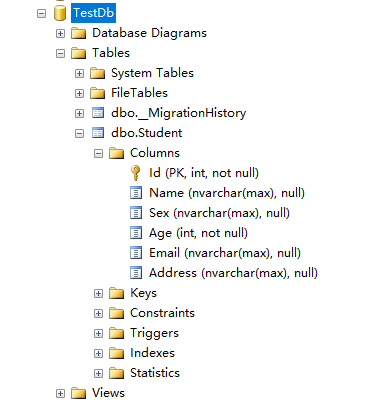
注意:如果处于生产环境,那么我们肯定不想丢失已经存在的数据。这时我们就需要关闭该初始化器,只需要将null传给Database.SetInitlalizer()方法,如下所示:
public SampleDbEntities(): base("name=AppConnection")
{
Database.SetInitializer<SampleDbEntities>(null);
}
2、填充种子数据
到目前为止,无论我们选择哪种策略初始化数据库,生成的数据库都是一个空的数据库。但是许多情况下我们总想在数据库创建之后、首次使用之前就插入一些数据。此外,开发阶段可能想以admin的资格为其填充一些数据,或者为了测试应用在特定的场景中表现如何,想要伪造一些数据。
当我们使用DropCreateDatabaseAlways和DropCreateDatabaseIfModelChanges初始化策略时,插入种子数据非常重要,因为每次运行应用时,数据库都要重新创建,每次数据库创建之后在手动插入数据非常乏味。接下来我们看一下当数据库创建之后如何使用EF来插入种子数据。
为了向数据库插入一些初始化数据,我们需要创建满足下列条件的数据库初始化器类:
1、从已存在的数据库初始化器类中派生数据。
2、在数据库创建期间种子化。
下面演示如何初始化种子数据
1、定义领域实体类
using System;
using System.Collections.Generic;
using System.ComponentModel.DataAnnotations.Schema;
using System.Linq;
using System.Text;
using System.Threading.Tasks; namespace InitializationSeed.Model
{
[Table("Employee")]
public class Employee
{
public int EmployeeId { get; set; }
public string FirstName { get; set; }
public string LastName { get; set; } }
}
2、创建数据库上下文
使用EF的Code First方式对上面的模型创建数据库上下文:
public class SampleDbEntities : DbContext
{
public virtual DbSet<Employee> Employees { get; set; }
}
3、创建数据库初始化器类
假设我们使用的是DropCreateDatabaseAlways数据库初始化策略,那么初始化器类就要从该泛型类继承,并传入数据库上下文作为类型参数。接下来,要种子化数据库就要重写DropCreateDatabaseAlways类的Seed()方法,而Seed()方法拿到了数据库上下文,因此我们可以使用它来将数据插入数据库:
using InitializationSeed.Model;
using System;
using System.Collections.Generic;
using System.Data.Entity;
using System.Linq;
using System.Text;
using System.Threading.Tasks; namespace InitializationSeed.EF
{ /// <summary>
/// 数据库初始化器类
/// </summary>
public class SeedingDataInitializer : DropCreateDatabaseAlways<SampleDbEntities>
{
/// <summary>
/// 重写DropCreateDatabaseAlways的Seed方法
/// </summary>
/// <param name="context"></param>
protected override void Seed(SampleDbEntities context)
{
for (int i = ; i < ; i++)
{
var employee = new Employee
{
FirstName="测试"+(i+),
LastName="工程师"
}; context.Employees.Add(employee); }
base.Seed(context);
}
}
}
上面的代码通过for循环创建了6个Employee对象,并将它们添加给数据库上下文类的Employees集合属性。这里值得注意的是我们并没有调用DbContext.SaveChanges()方法,因为它会在基类中自动调用。
4、将数据库初始化器类用于数据库上下问类
using InitializationSeed.Model;
using System;
using System.Collections.Generic;
using System.Data.Entity;
using System.Linq;
using System.Text;
using System.Threading.Tasks; namespace InitializationSeed.EF
{
public class SampleDbEntities :DbContext
{
public SampleDbEntities()
: base("name=AppConnection")
{
// 类型传SeedingDataInitializer
Database.SetInitializer<SampleDbEntities>(new SeedingDataInitializer());
} // 领域实体添加到数据上下文中
public virtual DbSet<Employee> Employees { get; set; }
}
}
5、Main方法中访问数据库
using InitializationSeed.EF;
using System;
using System.Collections.Generic;
using System.Linq;
using System.Text;
using System.Threading.Tasks; namespace InitializationSeed
{
class Program
{
static void Main(string[] args)
{
using (var context = new SampleDbEntities())
{
foreach (var item in context.Employees)
{
Console.WriteLine("FirstName:"+item.FirstName+" "+"LastName:"+item.LastName);
}
} Console.WriteLine("读取完成");
Console.ReadKey();
}
}
}
6、运行程序,查看结果
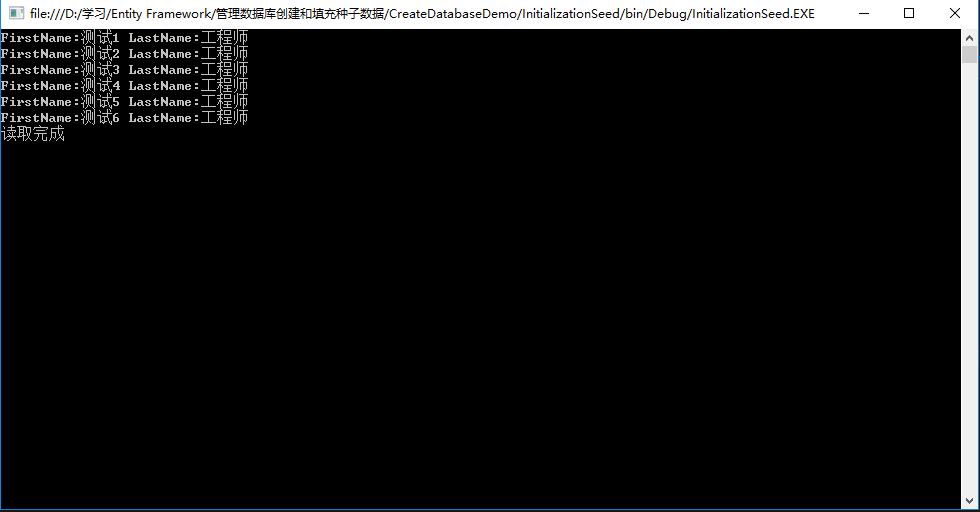
查看数据库
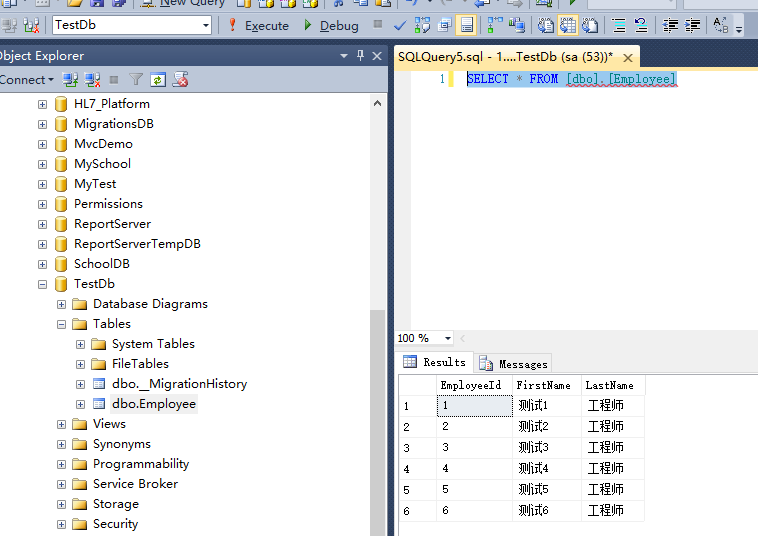
种子数据填充完成。
5、使用数据迁移的方式填充种子数据
使用数据迁移的方式会生成Configuration类,Configuration类定义如下:
namespace DataMigration.Migrations
{
using System;
using System.Data.Entity;
using System.Data.Entity.Migrations;
using System.Linq; internal sealed class Configuration : DbMigrationsConfiguration<DataMigration.SampleDbEntities>
{
public Configuration()
{
AutomaticMigrationsEnabled = false;
} protected override void Seed(DataMigration.SampleDbEntities context)
{
// This method will be called after migrating to the latest version. // You can use the DbSet<T>.AddOrUpdate() helper extension method
// to avoid creating duplicate seed data.
}
}
}
重写Configuration类的Seed()方法也可以实现插入种子数据,重写Seed()方法:
namespace DataMigration.Migrations
{
using DataMigration.Model;
using System;
using System.Data.Entity;
using System.Data.Entity.Migrations;
using System.Linq; internal sealed class Configuration : DbMigrationsConfiguration<DataMigration.SampleDbEntities>
{
public Configuration()
{
AutomaticMigrationsEnabled = false;
} protected override void Seed(DataMigration.SampleDbEntities context)
{
// This method will be called after migrating to the latest version. // You can use the DbSet<T>.AddOrUpdate() helper extension method
// to avoid creating duplicate seed data. context.Employees.AddOrUpdate(
new Employee { FirstName = "测试1", LastName = "工程师" },
new Employee { FirstName = "测试2", LastName = "工程师" } );
}
}
}
使用数据迁移,然后查看数据库结果:
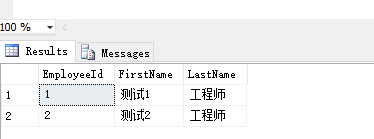
发现使用数据迁移的方式也将种子数据插入到了数据库中。
代码下载地址:https://pan.baidu.com/s/1i5By8EL
Entity Framework应用:使用Code First模式管理数据库创建和填充种子数据的更多相关文章
- Code First开发系列之管理数据库创建,填充种子数据以及LINQ操作详解
返回<8天掌握EF的Code First开发>总目录 本篇目录 管理数据库创建 管理数据库连接 管理数据库初始化 填充种子数据 LINQ to Entities详解 什么是LINQ to ...
- 8天掌握EF的Code First开发系列之3 管理数据库创建,填充种子数据以及LINQ操作详解
本文出自8天掌握EF的Code First开发系列,经过自己的实践整理出来. 本篇目录 管理数据库创建 管理数据库连接 管理数据库初始化 填充种子数据 LINQ to Entities详解 什么是LI ...
- Entity Framework应用:Code First模式数据迁移的基本用法
使用Entity Framework的Code First模式在进行数据迁移的时候会遇到一些问题,熟记一些常用的命令很重要,下面整理出了数据迁移时常用的一些命令. 一.模型设计 EF默认使用id字段作 ...
- Entity Framework应用:使用Code First模式管理事务
一.什么是事务 处理以数据为中心的应用时,另一个重要的话题是事务管理.ADO.NET为事务管理提供了一个非常干净和有效的API.因为EF运行在ADO.NET之上,所以EF可以使用ADO.NET的事务管 ...
- Entity Framework应用:使用Code First模式管理视图
一.什么是视图 视图在RDBMS(关系型数据库管理系统)中扮演了一个重要的角色,它是将多个表的数据联结成一种看起来像是一张表的结构,但是没有提供持久化.因此,可以将视图看成是一个原生表数据顶层的一个抽 ...
- 学习Entity Framework 中的Code First
这是上周就写好的文章,是在公司浩哥的建议下写的,本来是部门里面分享求创新用的,这里贴出来分享给大家. 最近在对MVC的学习过程中,接触到了Code First这种新的设计模式,感觉很新颖,并且也体验到 ...
- 转载:学习Entity Framework 中的Code First
看完觉得不错,适合作为学习资料,就转载过来了 原文链接:http://www.cnblogs.com/Wayou/archive/2012/09/20/EF_CodeFirst.html 这是上周就写 ...
- Entity Framework 6.x Code Frist For Oracle 实践与注意点
Entity Framework 6.x Code Frist For Oracle 实践与注意点 开发环境 Visual Studio.net 2015/2017 Oracle 11g/12c 数据 ...
- Entity Framework 6.x Code First 基础
安装扩展工具 "Entity Framework Power Tools Beta4" 可选, 主要用于数据库变结构反向生成C#的对象和对应的mapping类.如果你熟悉mappi ...
随机推荐
- Python log10() 函数
描述 log10() 方法返回以10为基数的x对数,x>0. 语法 以下是 log10() 方法的语法: import math math.log10( x ) 注意:log10()是不能直接访 ...
- JAVA-day08 下午-总结、測试
继承总结: class { public static void main(String[] args) { System.out.println("Hello World!"); ...
- 【转】用SQL实现树的查询
树形结构是一类重要的非线性结构,在关系型数据库中如何对具有树形结构的表进行查询,从而得到所需的数据是一个常见的问题.本文笔者以 SQL Server 2000 为例,就一些常用的查询给出了相应的算法与 ...
- TCP通信的三次握手和四次撒手的详细流程(顿悟)
TCP(Transmission Control Protocol) 传输控制协议 三次握手 TCP是主机对主机层的传输控制协议,提供可靠的连接服务,采用三次握手确认建立一个连接: 位码即tcp标志位 ...
- 【Android】11.3 屏幕旋转和场景变换过程中GridView的呈现
分类:C#.Android.VS2015: 创建日期:2016-02-21 一.简介 实际上,对于布局文件中的View来说,大多数情况下,Android都会自动保存这些状态,并不需要我们都去处理它.这 ...
- 利用yacc和lex制作一个小的计算器
买了本<自制编程语言>,这本书有点难,目前只是看前两章,估计后面的章节,最近一段时间是不会看了,真的是好难啊!! 由于本人是身处弱校,学校的课程没有编译原理这一门课,所以就想看这两章,了解 ...
- Serviceability
http://hg.openjdk.java.net/jdk7u/jdk7u2/hotspot/file/6259c6d3bbb7/agent/doc/clhsdb.html http://blog. ...
- 李洪强iOS开发之-sql数据库的使用
一,创建工程 二: 导入头文件 三:导入 四: 数据库增删改查 //因为是结构体类型,所以用assign //1.创建数据库(保存路径) @property(nonatomic,assign)sqli ...
- CSocket类网络编程 MFC
Visual C++的MFC提供了CSocket类用来实现网络通信. 下面介绍VC++在Windows 95中实现Socket的 CSocket 类相关成员函数(这些成员函数实际上是从CAsyncSo ...
- LINQ架构简单描述
写在前面的话:课堂上老师只是简单提了一下LINQ,当时听着老师对它的描述,感觉非常神奇,不用去操作繁琐的SQL语句了,读取数据库的操作居然能向写C#代码一样方便,但是一直没有机会去学习使用它. LIN ...
